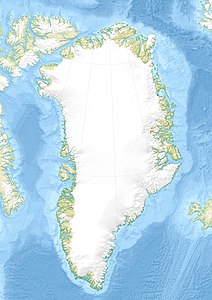Hvalrosø
| Hvalrosø | ||
|---|---|---|
| Hvalrosø as Wallross I. south of Sabine Ø on a map from 1874 | ||
| Waters | Greenland Sea | |
| Archipelago | Pendulum Islands | |
| Geographical location | 74 ° 30 '48 " N , 18 ° 45' 39" W | |
|
|
||
| length | 1.8 km | |
| width | 200 m | |
| surface | 1.5 km² | |
| Highest elevation | 85 m | |
| Residents | uninhabited | |
Hvalrosø ( German also Walrus Island ) is an uninhabited island in the Northeast Greenland National Park and belongs to the Pendulum Islands . The island is rich in remnants of previous settlement.
geography
As the southernmost island of the group, Hvalrosø is about 2 kilometers southeast of the Germania harbor of Sabine Ø and represents a natural pack ice protection for it. The terrain rises slowly from the low west coast towards a steep, 85 m high cliff in the extreme northwest. There are two small lakes in the west of the island. Basalt dominates rocks .
Hvalrosø is located at the southern end of Sirius Water Polynja , a usually ice-free marine area between the coastal fixed ice and the pack ice that stretches from Shannon Island in the north and has a large concentration of marine mammals in spring .
history
The British Douglas Charles Clavering was the first European to reach the Pendulum Islands in 1823 with the HMS Griper . He named the group after the pendulum seconds with which Edward Sabine carried out gravity field measurements here . The island of Hvalrosø got its name from Carl Koldewey , the leader of the Second German North Pole Expedition , which wintered with the screw steamer Germania in the nearby Germaniahafen in 1869/70 , because of the walruses that can often be found here . In 1921 the Østgrønlandske Fangstkompagni built a small depot hut in the southeast of the island. It was later moved to the southwest side and is now a ruin.
In 1926, the Cambridge University expedition to East Greenland , led by James Wordie , discovered the remains of a prehistoric settlement on Hvalrosø. A detailed investigation was only carried out in 2008 by Bjarne Grønnow as part of the GeoArk expedition of the Greenland National Museum and the Institute for Geography at the University of Copenhagen .
Archaeological finds
Hvalrosø is an important archaeological site. Above all on the beach terraces in the west of the island, which is just 1.5 km² in size, over 2000 stone structures such as tent rings, protective walls, granaries of various sizes and types, paving and the like were found. Most of the artifacts could be attributed to the Thule culture . The fact that no Thule winter houses such as those on Sabine Ø were found proves that the island was only settled seasonally by the Thule Inuit. They apparently came to Hvalrosø in the spring, when the Sirius Water Polynja, with its abundance of seals and whales, allowed them to stock up on meat reserves for the next winter.
445 artefacts have been identified as residential structures of the Paleo-Eskimos of the Independence I , Saqqaq and Dorset cultures . It seems possible that some structures attributed to the Dorset culture could have formed the basis for snow houses . The Dorset Eskimos could have lived on the island all year round.
Individual evidence
- ↑ a b Mikkel Sørensen: Walrus Island - A pivotal place for High Arctic Palaeo-Eskimo societies in Northeast Greenland . In: Études / Inuit / Studies . Volume 36, No. 1, 2012, pp. 183-205 (English). doi: 10.7202 / 1015959ar
- ↑ a b c Bjarne Grønnow et al. : At the edge: High Arctic Walrus hunters during the Little Ice Age . In: Antiquity . Volume 85, No. 329, 2011, pp. 960-977. doi: 10.1017 / S0003598X00068423
- ^ Association for the German north polar voyage in Bremen: The second German north polar voyage in the years 1869 and 1870 under the leadership of Captain Karl Koldewey . 1st volume, FA Brockhaus, Leipzig 1874, p. 314 .
- ↑ Anthony K. Higgins: Catalog of place names in northern East Greenland (PDF; 9.4 MB). In: Exploration history and place names of northern East Greenland (= Geological Survey of Denmark and Greenland Bulletin 21, 2010), ISBN 978-87-7871-292-9 . P. 263199 (English).

